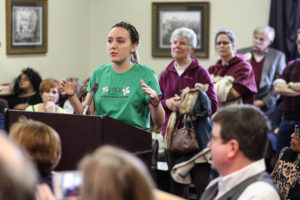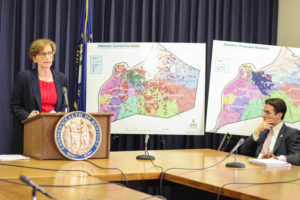YOU’RE TESTING MY LIMITS- Why do some leaders want our schools to change, and do they have a better plan for JCPS? We break down what you need to know about neighborhood schools, charters, and new leadership.
As we woke up for school on the morning of April 14, most of us were unaware of the looming changes happening within our school system. As we brushed our teeth, combed our hair, and laced our shoes, questions about the day ahead raced through our minds. Will the biology test really be as hard as people say it is? Who should I pick as a partner for my social studies project? What’ll they serve for lunch today?
Similar school-oriented thoughts occupied our teachers as well: How many days till summer break? Will I have time to grade these tests? What’ll they serve for lunch today? But that morning as our teachers arrived, many of them found a surprise in their school mailboxes. It was a small gift from the district – rectangular magnets bearing a pre-printed message of appreciation from Dr. Donna Hargens, the superintendent of our schools, along with her signature. In bold letters, the magnets read, “I AM JCPS.”
Ironic, considering how soon Hargens herself would not be able to claim the same sentiment. The evening before, Hargens, the only superintendent that many JCPS students can remember, had conceded to pressure from the Board of Education (BoE) and negotiated an end to her contract.
To most of us, this news was just another conversation in passing. But this announcement from Hargens was actually one of many important headlines regarding the operation of JCPS in the past few months; neighborhood schools, a statewide audit, and charter schools have all been in the news.
It’s been hard to follow all of that news over the last year, since we’ve got academics to stress over, friendships to juggle, and issues outside of school to deal with on top of that. Even trying to understand conversations about state politics and school boards means we have to know the context of these changes – from education jargon to the current district policies to the Louisville history that has shaped JCPS.
But when it comes to school, we are the primary stakeholders: any changes will affect us most of all.
So let’s educate ourselves on what it will really mean to say “I AM JCPS” in the coming years.
To really understand it all, we have to start from the beginning.
In 1954, the Supreme Court case Brown v. Board of Education changed the face of public school education forever when it established that separate but equal institutions were inherently unjust, and thus state laws forming segregated schools were unconstitutional. This ruling was the first step to desegregation in Louisville, but in schools it was more symbolic than problem-solving. Public schools were still largely separated by neighborhoods, so neighborhoods that were majority white by default had predominantly white schools; likewise, black neighborhoods had black schools.
On top of that, after legislators passed a series of civil rights laws in the 1960s, Louisville became more segregated than it had ever been before, according to Dr. Catherine Fosl, a professor at the University of Louisville’s Anne Braden Institute for Social Justice Research. Specifically, after the Fair Housing Act of 1968, whites fled areas like West Louisville in favor of the newly constructed suburbs. So, while segregation was no longer legally enforced after the Civil Rights Act of 1964, the citizens of Louisville were electing to separate themselves.
But in the 1970s things started to really change in Louisville’s schools. After the 6th U.S. Circuit Court of Appeals ordered Jefferson County to do something about the segregation that remained in its schools, officials took new steps toward widescale integration. The main way JCPS officials desegregated was through a system of forced busing: taking students from one neighborhood and assigning them to a school across town to even out the racial ratio.
This new system and the protests it sparked put Louisville in a national spotlight, Fosl said. There were mobs, roadblocks, and demonstrations, all part of an effort to harass black children right back into segregation.
These changes took a toll on Louisvillians. Some parents even pulled their kids out of the public school system and put them in private schools to avoid busing and integration.
In 1984, the district adopted a new plan to desegregate middle and high schools – satellite areas and magnets. While most students could now go to a school close to their home, magnet schools and programs were implemented so that students could self-select integration. In addition, magnet programs offer specialized learning focused on a specific content area (for example, technology or visual arts). Satellite areas were added, which meant that students could be assigned to a school far away as their home school.
But it wasn’t long until there were new educational changes on the horizon. In 1990, Democratic Gov ernor Wallace Wilkinson signed the Kentucky Educational Reform Act (KERA) into law. This sweeping piece of legislation was enacted to combat the struggles Kentucky was having with its educational outcomes.
ernor Wallace Wilkinson signed the Kentucky Educational Reform Act (KERA) into law. This sweeping piece of legislation was enacted to combat the struggles Kentucky was having with its educational outcomes.
Before KERA, Kentucky ranked 50th in the nation for adult literacy and had the lowest percentage of adults with a high school diploma in America. In 1983, MIT economist David Birch described Kentucky as a “third world country with the nation’s most uneducated workforce.” This lead to 66 poor school districts suing the state in 1985, arguing that the financing of schools was inadequate and unequal. In the 1989 decision of Rose v. Council for Better Education, Kentucky’s Supreme Court declared the state’s whole school system unconstitutional. Additionally, the state Supreme Court ordered the General Assembly to redistribute funding and guarantee equal educational opportunities for all students.
KERA was the General Assembly’s attempt to remedy the state’s shortcomings. The act, in addition to dealing with the funding problem, attempted to make other changes in regards to accountability, student assessment, and legislative oversight of school districts.
KERA, a bipartisan effort, put Kentucky’s educational system in national headlines again, but this time the stories were positive.
Even President George H.W. Bush, a Republican, approved of this initiative that came from the left, signaling a sense of unity between the parties. In April 1990, Bush said, “In Kentucky, an entirely new philosophy of management is being put into place which is based on … accountability. That kind of creative thinking is government’s best role in education – setting goals, providing incentives, and then demanding accountability.”
Despite all of the praise heaped on Kentucky for its educational innovations, there were still problems with school districts across the state, including JCPS.
Fast forward 17 years, and JCPS is still grappling with some of the same issues as it was back then, among them low test scores, lack of resources, and long bus rides.
THE FIGHT THAT JUST WON’T END
Let’s start with one of those problems: long bus rides, which brings us back to the whole concept of busing. Truth be told, busing is inconvenient. It’s getting up early and getting home late, sitting in an uncomfortable or crowded bus for up to 2-3 hours a day. It’s living far away from school and sometimes having to skip basketball practice or student council so you have a guaranteed ride home.
Those are the reasons that some people in Jefferson County would like to go back to neighborhood schools. Namely, Representative Kevin Bratcher (R) from Fern Creek, sponsor of House Bill 151 (HB151), also known as the ‘neighborhood schools bill.’
The bill, introduced on Jan. 6, aimed to give parents the option of placing their children in the school nearest to them, provided that the school was not a magnet or traditional school.
Currently, high school students are assigned a ‘home school,’ and while home schools can be nearby, the satellite areas JCPS set up to promote diversity within schools don’t guarantee a short drive. Aside from home schools, JCPS has a multitude of magnets offering instruction in a specific content area or career path.
Under HB151, students would still be allowed to apply to magnet schools and programs. To understand the intended effects of the bill, it’s important to distinguish that “magnet programs,” such as the ones found at high schools like Atherton, Ballard, and Fern Creek, would be at risk, while “magnet schools,” which have no school enrollment based on residency, would be left alone. Under HB151, those schools with magnet programs and neighborhood students could have potentially filled up with the population of the surrounding area before any magnet applicants were even considered.
Because of busing, the location of a school doesn’t have to be determined by the surrounding population; for the last several decades, students have traveled all across town to go to school. This introduces one of the logistical problems associated with switching to neighborhood schools. Take Atherton as an example: Because of population density in the Highlands, Atherton, relative to other schools in JCPS, would have a very large residential population. Students applying to Atherton from elsewhere wouldn’t have even had their applications reviewed if all of the students around Atherton elected to attend, according to an analysis presented by JCPS officials.
“It would actually provide less choice for families,” said Dena Dossett, Chief of Data Management for JCPS, regarding HB151. “It also limits diversity. We know that, because of residential segregation and segregated housing patterns, if we went to a neighborhood schools plan, then some schools would be less diverse than they are now.”
Indeed, Jefferson County officials chose to continue busing students long after the court stopped its oversight because they recognized diversity as being important to education. According to a report by educational researchers at The Century Foundation, students in racially and socioeconomically diverse classrooms have higher test scores, are more likely to attend college, and are less likely to drop out before they graduate high school. Additionally, patterns of segregation are fiscally irresponsible for a community in the long run, according to a study called “The Cost of Segregation” published on March 28 and conducted in Chicago by the Urban Institute with Chicago’s Metropolitan Planning Council. People who grow up in a segregated setting are likely to have lower incomes and contribute less to their community’s economy, the study said.
Plus, many students elect to be bused to JCPS’s many magnet programs. Take, for example, Maddie Karcher (18), a senior in Atherton’s International Baccalaureate (IB) program. Like most high school students, Karcher hates waking up early, but she woke up at 5:15 a.m. every day during her freshman and sophomore years so she could catch the bus by the time it arrived.
“The bus was honestly awful,” Karcher said. “It came at 6 o’clock in the morning, and I didn’t get home until at least 3:45 because I had to go to a depot. That was really aggravating, but it was never aggravating to the point where I ever considered switching schools.”
From the time she was in middle school, Karcher knew her home school of Jeffersontown High wasn’t the right choice for her. Karcher wanted the chance to take on a more challenging curriculum in high school. Indeed, it was in Atherton’s IB biology class that Karcher was introduced to ecology; because of the class, Karcher made plans to major in ecology at Concordia University in Montreal.
Karcher and many other students, parents, and community leaders were upset by the proposed neighborhood schools legislation, so they rallied against the bill at JCPS administrative offices and in Frankfort at the Capitol.
Eventually, HB151 passed in the House but failed to get a full vote in the Senate. That said, HB151 may not be gone for good; it’s not the first failed neighborhood schools bill in the past 10 years.
In 2011, Kentucky’s Senate passed a similar bill, with a 21-17 vote. Republican Senator Den Seum from Jefferson County co-sponsored Senate Bill 3 (SB3) with former Senate President David Williams, a Republican from Burkesville. SB3 would have changed Jefferson County’s student assignment plan by instituting both neighborhood and charter schools, but the bill failed after being introduced in the House.
In the same year, the JCPS BoE decided to let former Superintendent Sheldon Berman go; one of the things for which Berman came under fire was the implementation of the student assignment plan. In 2007, the year Berman took the superintendent position, JCPS was forced to change its student assignment plan after the Supreme Court struck it down for being racially discriminatory. In the following years, parents complained that their students were being placed in schools far away, enduring sometimes hours-long bus rides.
Hargens, too, endured comments about busing for her entire tenure; these complaints, among others, contributed to diminishing public approval over the years, along with added tension with the BoE.
WHY IS HARGENS GOING?
Last fall, as Chris Kolb was running for his seat on the Jefferson County BoE, one of his campaign platforms was that new leadership was needed within JCPS. Kolb, who later won the District 2 seat over former BoE chairman David Jones Jr., went door-to-door in his district, assessing his neighbors’ problems with the current school system. He reported that most of them had the same concern: urgency.
 “The biggest thing that I observed, which was corroborated by the thousands of people whose doors we knocked on in the district, was that we needed a greater sense of urgency to fix some of the shortcomings the district was facing,” Kolb said. “People were just getting impatient on the pace of improvements on some critical issues.”
“The biggest thing that I observed, which was corroborated by the thousands of people whose doors we knocked on in the district, was that we needed a greater sense of urgency to fix some of the shortcomings the district was facing,” Kolb said. “People were just getting impatient on the pace of improvements on some critical issues.”
In fact, more than just Kolb’s constituents are getting restless with JCPS’s rate of improvement.
On Feb. 8, in an interview with conservative talk show host Leland Conway, Governor Matt Bevin said, “JCPS is a disaster in terms of the educational results. They have more failing schools than the entire rest of the state combined. It is an absolute, unmitigated mess.”
Results from state test scores in the 2015-2016 year show that more than half of the students in the district are not performing at grade level in reading and math. Furthermore, data from the Kentucky Department of Education (KDE) revealed that only 66 of the district’s 139 tested schools met the state’s annual performance goal; that number is down from 74 schools in the 2014-2015 school year and 96 in 2013-2014.
Moreover, the achievement gap between black and white students widened from 28.4 percent in the 2014-2015 school year to 29.4 percent in 2015-2016. And while 58 percent of white students scored proficient in reading and math, only 29 percent of black students did.
In addition to its problems with educational results, JCPS is undergoing a state management audit which could potentially lead to a state takeover.
In a Courier-Journal article about the audit published on Feb. 14, Kentucky’s Commissioner of Education Steven Pruitt noted that he was concerned in particular with safety measures used in JCPS, including the usages of seclusion and restraint. Some other areas the audit is focusing on are discrepancies in data, communication within the district, and disproportionate punishments among students.
Hargens has served as JCPS superintendent since the 2011-2012 school year, when she left her job in Wake Forest, N.C., to replace Berman. Her contract wasn’t due to expire until June 2019, but at a special meeting on April 13, Hargens and the BoE negotiated an end to her contract, effective July 1. In exchange for her resignation, the board will pay Hargens $48,000 in place of the money she would have received for healthcare benefits, and ultimately she could receive up to $200,000 of the amount she was to receive under her prior contract.
The BoE is currently interviewing candidates for the position of interim superintendent.
Kolb said that the interim superintendent will likely be in place for the state maximum of nine months. State law stipulates that a district can only hire an interim for six months, and their contract can be renewed, at most, for three more months.
“After we get the interim in place, we’re going to look at a number of factors for the permanent superintendent,” said Chris Brady, the board chair. “The most important factor being ‘what does the community have to say?’”
UNCHARTED TERRITORY
Whoever is chosen as the new superintendent will have an additional challenge ahead of them, one that no superintendent in Kentucky has ever faced:
charter schools.
On March 21, Governor Bevin
signed into law House Bill 520 (HB520), which allows the creation of charter schools in Kentucky.
Unlike public schools, which operate under the school board and district, charter schools are run by outside organizations. Charters are publicly funded through taxes, and do not charge tuition.
To establish a charter school, the outside organizations must sign a contract, or a charter, with an authorizer. Under HB520, either the local school district or the mayors of Louisville and Lexington have the right to authorize charters within their jurisdiction.
The reasoning behind the bill, as written in its text, is that “reducing achievement gaps in Kentucky is necessary for the state to realize its workforce and economic development potential.” The sponsors of the bill, Republicans John Carney and Richard Heath, said that the past and present measures to reduce these learning gaps have been insufficient.
Advocates of charters say that having fewer regulations allows for more innovative ways of teaching and thus better educated students. There is also the idea that charter schools will push those in charge of public schools to improve because of the increased sense of competition.
“Public education should not be about competition,” Brady said of charters. “It should be about providing an environment that’s conducive to learning and cooperation among many partners throughout the community.”
In 1991, Minnesota became the first state to enact charter school legislation. Since then, 44 other states have approved charter school laws, including Kentucky. Because other states have had charters for nearly 30 years, there is a lot of data out there, but the results have been mixed.
One success story is that of Keiller Leadership Academy, a K-8 charter school in San Diego, formerly known as Keiller Middle School. When the school was reopened as a charter in 2005, administrators and teachers partnered with the University of San Diego (USD) to develop new structure, schedule, and curriculum for what was once listed by the Department of Education as a top ten “persistently dangerous school.” According to the California Charter Schools Association, in its first year as a charter, suspensions at Keiller declined by 33 percent and teacher retention increased by 40 percent. USD faculty taught professional development to Keiller staff and USD students served as tutors and student-teachers to Keiller students; by its second year Keiller had improved its score on California’s Academic Performance Index by 79 points (each school has between 200 and 1000 points).
However, critics argue that many charters don’t actually serve all students, and instead only benefit those whose parents can afford to spend the time and effort required by contracts that charters want parents to sign. These requirements exclude many working parents who can’t take off work for required volunteer hours. In addition, having the wherewithal and resources to enroll one’s child in a charter school is often beyond the grasp of working-class and impoverished families.
Charter schools have not been universally successful, which led the JCPS BoE to be hesitant about their arrival in Kentucky, especially given the terms of their authorization.
During a board meeting on Jan. 10, the JCPS BoE adopted the position that the sole authorizers of charter schools should be locally-elected school boards. When the board learned that Mayor Greg Fischer had been working with legislators in Frankfort to give him the power to authorize charter schools in Jefferson County, Kolb and some other members felt betrayed.
“With HB520, the mayor really overstepped his bounds,” Kolb said. “When you look at places with mayoral control [of the school district], most notably Chicago, it’s just an absolute wreck.”
Indeed, charter schools in Chicago have come under fire after data showed that children attending charter schools underperformed those in Chicago Public Schools. A study from the Institute on Metropolitan Opportunity at the University of Minnesota Law School claimed that growth and pass rates in reading and math were lower at charter schools, as are graduation rates. Additionally, charter schools are less diverse than traditional schools with only 7 percent of Chicago charter schools found to be diverse, compared to the 20 percent of Chicago neighborhood schools that are considered to be diverse. Chicago Mayor Rahm Emanuel is a proponent of charter schools; while he does not have the power to authorize charter schools himself, he does appoint the authorizing body – the school board – giving him added control.
Under HB520, Kentucky could see charter schools as soon as the 2018-2019 school year. With Mayor Fisher, a proponent of the ‘choice school movement’ and charters, serving as an authorizer, Louisville could see them in the 2018-2019 school year as well.
SO WHAT’S NEXT?
Though stakeholders may disagree on the course of action needed within JCPS, they agree that some kind of change is needed within Jefferson County and its schools.
One of the BoE’s main objectives is to close the achievement gap, which Kolb said should be handled partially through a mixture of restorative practices and cultural competency training.
“At this point we are a minority-majority district; more than half of our students are nonwhite,” Kolb said. “That’s who we are, and we have to do a better job of serving those students.”
Kolb also said that Metro government, specifically Metro Council, needs to take measures to ensure the success of students before they even get in the classroom.
“When you’re trying to educate kids that come from extreme poverty – kids that may not have eaten breakfast or dinner the night before, kids that might have slept a different place every night for the past week because they have housing insecurity – we’re just not going to be greatly successful in educating those kids,” Kolb said. “The whole community needs to call upon Metro Council to do a better job of taking care of children in our city.”
The bottom line is that there’s a lack of student achievement in Jefferson County. Some people blame segregation, while others blame busing, saying it’s time to go back to neighborhood schools so the community in one neighborhood will push its kids to succeed.
Some say the problem is the system itself. With over 100,000 students, JCPS is one of the largest school systems in America, and so some advocates claim charter schools can cater more specifically to student needs and compete with public schools in a way that will make both both successful.
Some say the problem is leadership, which is why they called for the exit of Hargens and are seeking a replacement who will listen to community concerns and act with an added urgency
But in all these discussions, there’s often a voice missing – the students of JCPS themselves. So it’s time that we, as students, take more responsibility for our school district. What can we do about our own success?
“Our board wants to make efforts to ensure that the student voice is heard and is a part of the conversation,” Brady said. “In my opinion as a board member, it is important that we hear that – it’s all about our kids – but far too often we don’t hear student voices and we’re trying to make changes to fix that.” •
Donations are collected through The Publishers, duPont Manual High School's booster club for J&C. On The Record relies completely on sponsorships, advertisements, and donations to produce and distribute each issue. Please consider donating to our cause, and helping the student journalists of OTR amplify youth voices for years to come.








